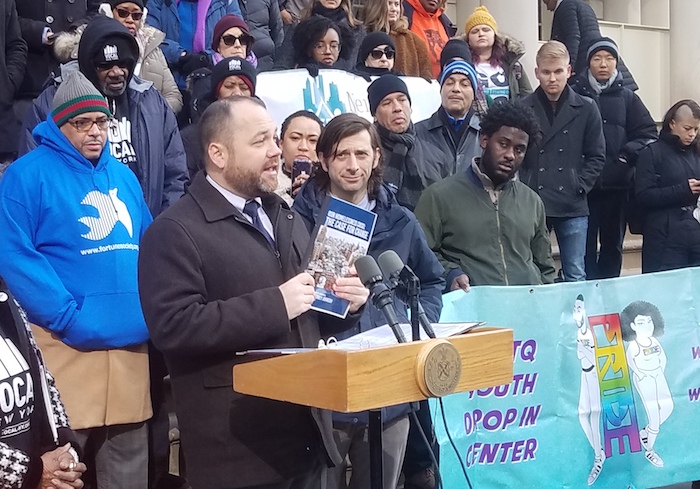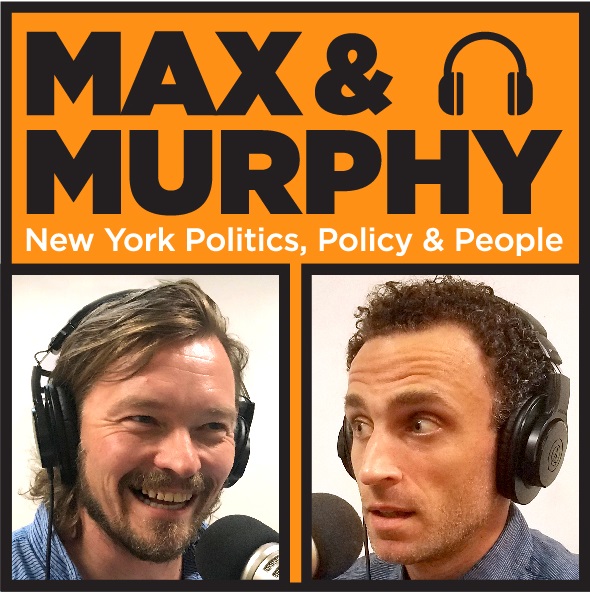
Jarrett Murphy
Speaker Johnson and Councilmember Levin at the unveiling of the Council’s homelessness report on January 30.New York’s modern homelessness problem, which first gained attention during the Koch administration, predates the creation of the City Council as we know it today.
It wasn’t until after the Supreme Court cast the Board of Estimate to the dustbin in 1989 and the city charter was changed that the local legislature gained its current share of governing power. By then, the crude image of the New York City homeless person—think of a shopping cart next to a cardboard box under an overpass—was indelibly stamped upon the city’s reputation.
Since that time the Council chamber has been where successive mayors tried to defend their approach to managing the homelessness problem, at hearings of the Council’s general welfare committee. In the 1990s, the irrepressible Steve DiBrienza grilled Mayor Giuliani’s homelessness team. In the 2000s a tall, bearded man from Brooklyn pursued a more conciliatory conversation with Mayor Bloomberg’s commissioners during that mayor’s first two terms; the questions got tougher from Anabel Palma during Bloomberg’s final tour. For the past six years, the once-bearded man has been mayor, and Stephen Levin has led the committee.
Meanwhile, thousands slept in the shelters, their numbers rising and falling, then rising and rising, on economic winds and policy shifts.
The Council’s release late last month of a report and policy blueprint on homelessness represents something different: a comprehensive and proactive approach to a crisis that multiple mayoral strategies have failed to corral.
Levin joined the WBAI Max & Murphy Show (Live at 5 p.m. at 99.5FM every Wednesday) this week to discuss the report.
Long history, divided management
In surveying the history of homelessness in New York, the report renders this assessment of recent mayors:
New York City has been struggling to address homelessness for decades, with varying success. The Koch and Dinkins Administrations recognized that permanent housing options were important, while the Giuliani Administration took a punitive approach to homelessness, restricting shelter access and criminalizing poverty. The Bloomberg Administration saw homelessness as an incentive problem, and while a key prevention program—Homebase—was created to help those at risk, rental subsidies and priority access to public housing were discontinued, resulting in an explosive increase in the homeless population. The de Blasio Administration has made strides, reinstituting rental assistance vouchers, enhancing street outreach teams to help unsheltered individuals come inside, and drastically reducing the homeless veteran population. But, right now, the homelessness crisis is only being managed.
The Council’s nearly 200-page report, which was two years in the making, proposes steps to address homelessness in all its facets: as a risk to those who could become homeless, a crisis for people who now are in shelters, and a trauma for those who have—for the moment—escaped the system.
It proposes everything from improving planning for those getting out of prison and making rental vouchers more broadly available to increasing the market value of those vouchers, targeting affordable housing to the city’s poorest, creating more “safe havens” and boosting support for those dealing with domestic violence, which is an increasingly visible driver of shelter use.
More fundamentally, it calls for an end to the odd bifurcation in the city’s approach to housing people, which treats the production of affordable housing and the handling of homelessness as separate portfolios (with public housing often as a third, separate bucket).
Need for immediate steps
At the unveiling of the report on January 30, Council Speaker Corey Johnson noted that the city has one deputy mayor who handles housing, and another who handles homelessness. “That makes no sense given the depth and breadth of this crisis,” Johnson said.
Backed by dozens of advocates on the City Hall steps on a frigid morning, the speaker alluded to the “national homelessness crisis” and said the Council’s goal in crafting the report had been to create a “long-term comprehensive plan.”
But he also stressed, “We must take immediate steps like increasing rental assistance voucher amounts.” Most of the proposals in the Council report are steps the city can take on its own, although some of the more significant moves would require support from the state.
“It doesn’t rely on simplistic, single new strategies,” Catherine Trapani of Homeless Services United, who spoke at the City Hall event, said of the report. “It’s not going to be one thing [that addresses homelessness]. If it were, we would have solved it already. It’s going to be lots of things, done to scale.”
Some of what the de Blasio administration has done is working, Trapani said.: Some segments of the homeless shelter census have leveled off in the past year. That is proof that policy can succeed, she said, but also an indication that more is needed.
On Max & Murphy, Levin broke down the report’s diagnosis of the homelessness problem and the lengthy list of fixes it has proposed.
“Some of it has to do with doubling down on existing policies but a lot of it has to do with things that we’ve been advocating for for years that are still not done. A lot of them are things we’ve been talking about for five, six years,” Levin said, like making sure runaway and homeless youth have options when they age out of the youth shelter system, and setting aside more subsidized housing for people in the shelter system. “There’s a lot of those kinds of common-sense solutions.”
Hear our conversation with Levin above. Below, you can listen to our discussion of the mayor’s state of the city address last week, or scroll down further to catch the full show – which includes discussion about the New Hampshire primary and Bloomberg’s recently unearthed 2015 comments on stop-and-frisk.








